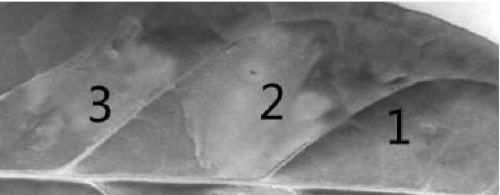Erwinia carotovora, plant immune activation protein secreted by it and application thereof
A technology of carrot soft rot and Erwinia, which is applied in the biological field to achieve the effect of avoiding residue and pollution, facilitating storage and transportation, and efficient prevention and control
- Summary
- Abstract
- Description
- Claims
- Application Information
AI Technical Summary
Problems solved by technology
Method used
Image
Examples
Embodiment 1
[0026] Example 1 Isolation and Screening of Bacterial Strains with Activation of Plant Immunity and Disease Resistance
[0027] The rotten Chinese cabbage in the plots with serious incidence of Chinese cabbage was collected as the test material. Bacteria were isolated from the sample in the laboratory, and the bacteria were isolated and purified on LB medium for many times. After the pure cultured bacteria were obtained, the strain identification was carried out.
[0028] Specific steps: the above soil samples come from Chinese cabbage fields infected with Chinese cabbage rot disease in Hebei Province, Shandong, Shanxi and other places. The samples are diluted in a gradient, spread on LB medium, and cultivated in a constant temperature incubator at 28°C. The above-mentioned medium was prepared according to the records in the "Microbial Culture Medium Manual". The formula of the medium is: 5g of beef extract, 10g of peptone, 5g of sodium chloride, 15g of agar, 1000ml of tap wate...
Embodiment 2
[0030] Example 2 Toxicity Test of No. 36 Bacterial Strain with Activation of Plant Immunity and Disease Resistance
[0031] The isolated No. 36 strain was activated in LB liquid medium and cultured at 25°C for 24 hours to prepare a bacterial suspension. After sterilizing the surface of healthy cabbage leaves with alcohol cotton for 3 times, rinse them with sterile water for 3 times, use a sterilized inoculation needle to prick 5 holes on each healthy cabbage leaf, and then add LB liquid bacterial suspension to each hole. Each treatment was repeated three times, and the addition of sterile LB medium was used as a control. Put the treated cabbage leaves into a white culture pot, cover the mouth of the pot with plastic wrap to keep moisture, place it in a constant temperature incubator at 25°C, and observe the disease after 24 hours and compare whether it is consistent with the symptoms in the field ( figure 2 ).
[0032] The isolated No. 36 strain was inoculated into a low-sa...
Embodiment 3
[0034] Example 3 Identification of antagonistic strains
[0035]According to the experimental content and experimental methods recorded in the "Common Bacteria System Identification Manual", the screened preservation number is: CGMCC No.11751 for identification, pick the cultures of the screened soft rot strains, and culture them in LB. After cultured at 28°C for 48 hours, the colony morphology was observed with naked eyes and photographed. The colonies of soft rot pathogens were picked for smear staining, and their characteristics were observed under a 4×100 magnification microscope.
[0036] The observation of colony morphology was carried out on LB medium. After the strains were streaked and inoculated, they were cultured at a constant temperature of 25° C. for 24 hours to observe the colony morphology. The colony of the strain with the preservation number CGMCC No. 11751 is round or irregular, slightly raised, off-white, shiny, translucent, smooth, and not tightly combine...
PUM
 Login to View More
Login to View More Abstract
Description
Claims
Application Information
 Login to View More
Login to View More - R&D
- Intellectual Property
- Life Sciences
- Materials
- Tech Scout
- Unparalleled Data Quality
- Higher Quality Content
- 60% Fewer Hallucinations
Browse by: Latest US Patents, China's latest patents, Technical Efficacy Thesaurus, Application Domain, Technology Topic, Popular Technical Reports.
© 2025 PatSnap. All rights reserved.Legal|Privacy policy|Modern Slavery Act Transparency Statement|Sitemap|About US| Contact US: help@patsnap.com



